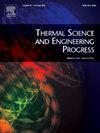Hybrid cooling systems for suppressing thermal runaway propagation in a lithium-ion battery module
IF 5.4
3区 工程技术
Q2 ENERGY & FUELS
引用次数: 0
Abstract
Five newly proposed suppression systems employing insulation boards, cold plates, and a phase change material (PCM), were comparatively studied to prevent thermal runaway propagation (TRP) in a lithium-ion battery (LIB) pack using a 3D numerical model. Effects of coolant flow velocity (u, 0.014–0.048 m/s) and coolant flow direction, presence of insulator, geometry and thickness (0.3–2.7 mm) of PCM boards on suppression performance were systematically analyzed. The results show that inserting insulation boards between two columns of batteries could prevent column-to-column TRP but accelerate in-column TRP. When using hybrid system of insulator and cold plates, cooling efficiency improves as u increases, and TRP was completely suppressed when u = 0.048 m/s. Cross flow outperforms unidirectional flow, and the transient and cumulative heat losses from LIBs to coolant are quantified. When most aluminum of cold plates between two columns of LIBs is replaced by insulator, column-to-column TRP can be suppressed even with lowest u. Adding PCM strips among mini-channels in cold plates slightly decelerates TRP, whereas inserting PCM boards between cold plates and batteries appreciably improves suppression performance of the hybrid system. PCM features high thermal conductivity after melting, acting as thermal sink and thermal buffer to prevent TRP. Compared to liquid cooling system, the hybrid system combining cold plates and PCM exhibits superior suppression efficiency.
抑制锂离子电池模块热失控传播的混合冷却系统
采用三维数值模型,对比研究了采用绝缘板、冷板和相变材料(PCM)的五种新提出的抑制系统,以防止锂离子电池(LIB)电池组的热失控传播(TRP)。系统分析了冷却剂流速(u, 0.014 ~ 0.048 m/s)、冷却剂流向、绝缘子是否存在、PCM板的几何形状和厚度(0.3 ~ 2.7 mm)对抑制性能的影响。结果表明,在蓄电池两柱之间插入绝缘板可以防止柱间TRP,但会加速柱内TRP。当采用绝缘子与冷板混合系统时,冷却效率随u的增大而提高,当u = 0.048 m/s时TRP被完全抑制。横向流动优于单向流动,从lib到冷却剂的瞬态和累积热损失被量化。当两柱间冷板的大部分铝被绝缘子取代时,即使在最低的u值下,也可以抑制柱间TRP。在冷板的小通道之间添加PCM条会略微降低TRP,而在冷板和电池之间插入PCM板可以明显提高混合动力系统的抑制性能。PCM熔化后具有高导热性,作为热沉和热缓冲,防止TRP。与液冷系统相比,冷板与PCM相结合的混合系统具有更好的抑制效果。
本文章由计算机程序翻译,如有差异,请以英文原文为准。
求助全文
约1分钟内获得全文
求助全文
来源期刊

Thermal Science and Engineering Progress
Chemical Engineering-Fluid Flow and Transfer Processes
CiteScore
7.20
自引率
10.40%
发文量
327
审稿时长
41 days
期刊介绍:
Thermal Science and Engineering Progress (TSEP) publishes original, high-quality research articles that span activities ranging from fundamental scientific research and discussion of the more controversial thermodynamic theories, to developments in thermal engineering that are in many instances examples of the way scientists and engineers are addressing the challenges facing a growing population – smart cities and global warming – maximising thermodynamic efficiencies and minimising all heat losses. It is intended that these will be of current relevance and interest to industry, academia and other practitioners. It is evident that many specialised journals in thermal and, to some extent, in fluid disciplines tend to focus on topics that can be classified as fundamental in nature, or are ‘applied’ and near-market. Thermal Science and Engineering Progress will bridge the gap between these two areas, allowing authors to make an easy choice, should they or a journal editor feel that their papers are ‘out of scope’ when considering other journals. The range of topics covered by Thermal Science and Engineering Progress addresses the rapid rate of development being made in thermal transfer processes as they affect traditional fields, and important growth in the topical research areas of aerospace, thermal biological and medical systems, electronics and nano-technologies, renewable energy systems, food production (including agriculture), and the need to minimise man-made thermal impacts on climate change. Review articles on appropriate topics for TSEP are encouraged, although until TSEP is fully established, these will be limited in number. Before submitting such articles, please contact one of the Editors, or a member of the Editorial Advisory Board with an outline of your proposal and your expertise in the area of your review.
 求助内容:
求助内容: 应助结果提醒方式:
应助结果提醒方式:


